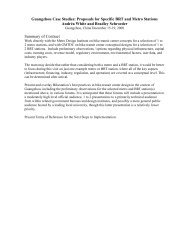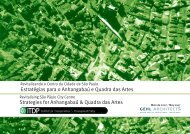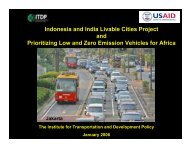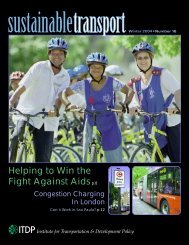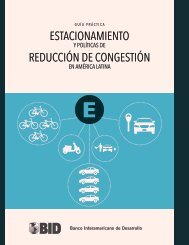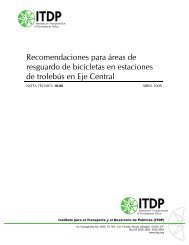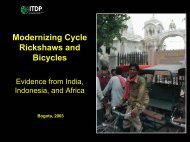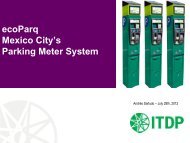Download PDF - ITDP | Institute for Transportation and Development ...
Download PDF - ITDP | Institute for Transportation and Development ...
Download PDF - ITDP | Institute for Transportation and Development ...
Create successful ePaper yourself
Turn your PDF publications into a flip-book with our unique Google optimized e-Paper software.
ing is also increasing the level of subsidies<br />
to motor vehicle use in China. The<br />
European Union has said that spending<br />
1.5% of GNP on transport investments is<br />
a sustainable level. While China has fast<br />
GDP growth, the recent level of spending,<br />
around 3.6% of GNP a year, (of<br />
which 72% is spent on roads) seems<br />
excessive. Last year alone, China spent<br />
more than $20 billion on infrastructure<br />
projects. Over 15,000 kilometers of new<br />
highways are planned between now <strong>and</strong><br />
2010. While the construction jobs have<br />
been important to lower income Chinese<br />
<strong>and</strong> to maintaining<br />
economic growth,<br />
with road user fees<br />
currently covering<br />
only 47% of infrastructure<br />
costs, <strong>and</strong> with<br />
gasoline prices only<br />
$0.25 per liter, (below<br />
even the low U.S.<br />
price of $0.37 per liter), the vast majority<br />
of Chinese who have no access to a company<br />
car or private motor vehicle end up<br />
subsidizing the tiny minority who do.<br />
World Bank economists feel that US$1<br />
per liter would be a closer reflection of<br />
actual delivered oil costs.<br />
Cyclists also face an increasing<br />
number of restrictions. While initial<br />
plans to ban bicycles in downtown<br />
Guangzhou were defeated, Guangzhou<br />
is marginalizing bicycles by consigning<br />
them to non-motorized vehicle (NMV)<br />
routes. New elevated roads have severed<br />
NMV <strong>and</strong> pedestrian routes. Shanghai<br />
plans to phase out bikes within the inner<br />
ring road by 2010, <strong>and</strong> its bike network<br />
is being taken over by mopeds <strong>and</strong><br />
motorized three-wheelers. In Beijing,<br />
segregated bicycle lanes were torn out to<br />
make more room <strong>for</strong> automobiles, <strong>and</strong><br />
those that remain are being taken over<br />
by motorists <strong>for</strong> parking. An increasing<br />
number of major thoroughfares <strong>and</strong> new<br />
highways ban bicycles. Formerly convenient<br />
bicycle parking is being relocated<br />
<strong>and</strong> the space is being utilized <strong>for</strong> motorcycle<br />
<strong>and</strong> car parking. This is evident in<br />
most new commercial <strong>and</strong> retail developments.<br />
As more <strong>and</strong> more people are operating<br />
motorized vehicles, safety conditions<br />
<strong>for</strong> non-polluting bicyclists <strong>and</strong><br />
pedestrians have deteriorated dramatically.<br />
Though the police in most cities<br />
release safety statistics monthly to the<br />
Ministry of Public Security in Beijing, the<br />
statistics are useless from a safety-planning<br />
perspective. While bike use is still<br />
growing in parts of China, <strong>and</strong> is stable<br />
in Beijing <strong>and</strong> most of Shanghai, in<br />
rapidly modernizing Guangzhou, bike<br />
use dropped from 34% of total trips to<br />
24% of total trips in a decade.<br />
To the West, the specter of a China<br />
as motorized as the U.S. is indeed harrowing.<br />
From a net exporter of oil be<strong>for</strong>e<br />
1993, today China imports 35 million<br />
barrels a year, despite levels of motorization<br />
that remain exceedingly low.<br />
As more <strong>and</strong> more people are operating<br />
motorized vehicles, safety conditions <strong>for</strong><br />
non-polluting bicyclists <strong>and</strong> pedestrians<br />
have deteriorated dramatically.<br />
Because of China’s immense population,<br />
small changes in assumptions about<br />
China’s motorization could throw future<br />
global oil dem<strong>and</strong> projections <strong>and</strong> greenhouse<br />
gas emission estimates off by<br />
100%.<br />
What Is Being Done<br />
With the U.S. still by far the most<br />
serious contributor to greenhouse gas<br />
emissions, <strong>and</strong> still failing to address its<br />
own greenhouse gas emissions problem,<br />
it is unlikely that many decision-makers<br />
in China are going to feel responsible <strong>for</strong><br />
their contribution to global warming.<br />
They are concerned, however, about<br />
urban air pollution <strong>and</strong> its serious health<br />
effects.<br />
Though nationally pollution from<br />
domestic heating <strong>and</strong> other point<br />
sources remains the most serious pollution<br />
problem, transport is the fastest<br />
growing source of urban air pollution,<br />
now responsible <strong>for</strong> 80% of CO, a majority<br />
of the particulates, <strong>and</strong> some 40% of<br />
NOx in major cities. China’s cities are<br />
more polluted than Japanese <strong>and</strong> U.S.<br />
cities despite much lower levels of motor<br />
vehicle ownership <strong>and</strong> use because the<br />
vehicles are much more polluting.<br />
Beijing currently has levels of suspended<br />
particulate matter more than four times<br />
the recommended WHO guidelines, <strong>and</strong><br />
NOx nearly triple the recommended<br />
guidelines. Current trends indicate that<br />
while particulate is stable, NOx emissions<br />
are likely to double in the next<br />
decade, while CO could increase by five<br />
times, causing serious public health<br />
problems.<br />
Basic air pollution control measures<br />
still have a long way to go. Ambient air<br />
quality st<strong>and</strong>ards are regularly violated,<br />
but there is no mechanism to en<strong>for</strong>ce<br />
them. Currently there are no tailpipe<br />
emission st<strong>and</strong>ards on light duty vehicles,<br />
heavy duty vehicles, mopeds, or<br />
motorcycles. Only 30% of new cars are in<br />
compliance with the comparatively<br />
weak Euro I st<strong>and</strong>ard, <strong>and</strong> virtually<br />
none of the existing vehicle fleet is in<br />
compliance. Most of the cars in China<br />
are manufactured using European <strong>and</strong><br />
U.S. manufacturing equipment dating<br />
from the early 1980s. This equipment,<br />
when used in Europe, produced vehicles<br />
in compliance with Euro I st<strong>and</strong>ards, but<br />
in China they do not because of the use<br />
of lower quality parts.<br />
Recommended national st<strong>and</strong>ards<br />
<strong>for</strong> light duty vehicles, heavy duty diesel<br />
vehicles, <strong>and</strong> motorcycles based on international<br />
st<strong>and</strong>ards are pending.<br />
Meanwhile the government has moved<br />
to phase out leaded gasoline, starting<br />
early next year, <strong>and</strong> Beijing has already<br />
started. This January, Beijing also adopted<br />
a host of tailpipe emission st<strong>and</strong>ards<br />
on its own, <strong>and</strong> is requiring fuel injection<br />
<strong>and</strong> other emission controls, <strong>and</strong> manufacturers<br />
have been scrambling to<br />
comply.<br />
Public officials are also well aware<br />
of the problems of traffic congestion, but<br />
it takes very different <strong>for</strong>ms in different<br />
cities. In Beijing, there are more than 1.2<br />
million vehicles, <strong>and</strong> the number of private<br />
<strong>and</strong> company cars is increasing by<br />
140,000 each year. Shanghai, by contrast,<br />
is so dense there is almost no parking,<br />
<strong>and</strong> there are only 5000 private cars<br />
altogether. Taxis are thus the mode of<br />
choice so far <strong>for</strong> the emerging uppermiddle<br />
class, <strong>and</strong> nearly 2 million taxi<br />
trips are taken each day, the highest<br />
continued on p.18<br />
Fall 1999 7





